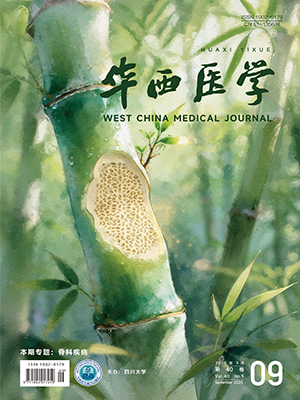| 1. |
GBD 2013 Mortality and Causes of Death Collaborators. Global, regional, and national age-sex specific all-cause and cause-specific mortality for 240 causes of death, 1990-2013: a systematic analysis for the Global Burden of Disease Study 2013. Lancet, 2015, 385(9963): 117-171.
|
| 2. |
Gulati R, Behfar A, Narula J, et al. Acute myocardial infarction in young individuals. Mayo Clin Proc, 2020, 95(1): 136-156.
|
| 3. |
Jortveit J, Pripp AH, Lang?rgen J, et al. Incidence, risk factors and outcome of young patients with myocardial infarction. Heart, 2020, 106(18): 1420-1426.
|
| 4. |
Karmen A, Wroblewski F, Ladue JS. Transaminase activity in human blood. J Clin Invest, 1955, 34(1): 126-131.
|
| 5. |
Kristjansson RP, Oddsson A, Helgason H, et al. Common and rare variants associating with serum levels of creatine kinase and lactate dehydrogenase. Nat Commun, 2016, 7: 10572.
|
| 6. |
Jaffe AS, Ravkilde J, Roberts R, et al. It’s time for a change to a troponin standard. Circulation, 2000, 102(11): 1216-1220.
|
| 7. |
Liu TT, Wang J, Liang Y, et al. The level of serum total bile acid is related to atherosclerotic lesions, prognosis and gut Lactobacillus in acute coronary syndrome patients. Ann Med, 2023, 55(1): 2232369.
|
| 8. |
Li W, Shu S, Cheng L, et al. Fasting serum total bile acid level is associated with coronary artery disease, myocardial infarction and severity of coronary lesions. Atherosclerosis, 2020, 292: 193-200.
|
| 9. |
Huang K, Liu C, Peng M, et al. Glycoursodeoxycholic acid ameliorates atherosclerosis and alters gut microbiota in apolipoprotein E-deficient mice. J Am Heart Assoc, 2021, 10(7): e019820.
|
| 10. |
張新超, 于學忠, 陳鳳英, 等. 急性冠脈綜合征急診快速診治指南(2019). 中國急救醫學, 2019, 39(4): 301-308.
|
| 11. |
Collet JP, Thiele H, Barbato E, et al. 2020 ESC guidelines for the management of acute coronary syndromes in patients presenting without persistent ST-segment elevation. Rev Esp Cardiol (Engl Ed), 2021, 74(6): 544.
|
| 12. |
Yntema T, Koonen DPY, Kuipers F. Emerging roles of gut microbial modulation of bile acid composition in the etiology of cardiovascular diseases. Nutrients, 2023, 15(8): 1850.
|
| 13. |
Zhang B, Kuipers F, de Boer JF, et al. Modulation of bile acid metabolism to improve plasma lipid and lipoprotein profiles. J Clin Med, 2021, 11(1): 4.
|
| 14. |
Nowiński A, Chabowski D, Giebu?towicz J, et al. Deoxycholic acid, a secondary bile acid, increases cardiac output and blood pressure in rats. Nutrients, 2023, 16(1): 32.
|
| 15. |
Wang J, Zhang J, Lin X, et al. DCA-TGR5 signaling activation alleviates inflammatory response and improves cardiac function in myocardial infarction. J Mol Cell Cardiol, 2021, 151: 3-14.
|
| 16. |
Miyazaki-Anzai S, Masuda M, Levi M, et al. Dual activation of the bile acid nuclear receptor FXR and G-protein-coupled receptor TGR5 protects mice against atherosclerosis. PLoS One, 2014, 9(9): e108270.
|
| 17. |
Wang J, Xu T, Xu M. Roles and mechanisms of TGR5 in the modulation of CD4(+) T cell functions in myocardial infarction. J Cardiovasc Transl Res, 2022, 15(2): 350-359.
|
| 18. |
Charach G, Rabinovich PD, Konikoff FM, et al. Decreased fecal bile acid output in patients with coronary atherosclerosis. J Med, 1998, 29(3/4): 125-136.
|
| 19. |
Charach G, Argov O, Geiger K, et al. Diminished bile acids excretion is a risk factor for coronary artery disease: 20-year follow up and long-term outcome. Therap Adv Gastroenterol, 2017, 11: 1756283X17743420.
|
| 20. |
Bassand JP, Hamm CW, Ardissino D, et al. Guidelines for the diagnosis and treatment of non-ST-segment elevation acute coronary syndromes. Eur Heart J, 2007, 28(13): 1598-1660.
|
| 21. |
Ussher JR, Elmariah S, Gerszten RE, et al. The emerging role of metabolomics in the diagnosis and prognosis of cardiovascular disease. J Am Coll Cardiol, 2016, 68(25): 2850-2870.
|
| 22. |
Xia JG, Li B, Zhang H, et al. Precise metabolomics defines systemic metabolic dysregulation distinct to acute myocardial infarction associated with diabetes. Arterioscler Thromb Vasc Biol, 2023, 43(4): 581-596.
|
| 23. |
Steyerberg EW, Vickers AJ, Cook NR, et al. Assessing the performance of prediction models: a framework for traditional and novel measures. Epidemiology, 2010, 21(1): 128-138.
|




